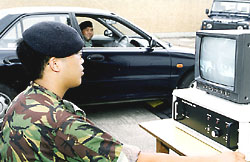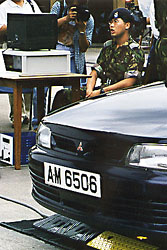



















|
|
CSP Tse said that since the start of the amalgamation of the FPD with Border District last December the total crime figures in the area along the boundary have fallen considerably: "A total of 133 crime cases were reported in Border District in the first quarter of this year, a decrease of 45 cases when compared with the last quarter of 1997." |
|
The detection rate is also improving, noted CSP Tse. "In 1997, 654 crime cases were reported and 279 were detected, showing a detection rate of nearly 43 per cent. In the first quarter of this year 64 cases in the border were detected - that's a detection rate of 48 per cent." The amalgamation of the FPD with the Border District has been introduced in phases to better police and improve anti-illegal immigration duties in the Border District. In the next phase of amalgamation, which takes place on July 5, the Sha Tau Kok Division will absorb the anti-illegal immigration duties normally performed by the Police Tactical Unit company in the area. "When the amalgamation is completed this October," said CSP Tse, who took up his post in September 1996, "police coverage and deployment in the Border District will be greatly improved. By then, disbanded PTU company members will be absorbed into each of the three divisions in the Border District and form the Border Enforcement Unit which will see officers serve from 18 months to two years - and work attractive five-day weeks." Added CSP Tse: "Prolonged tenure will increase officers' familiarity with the area and its residents giving them an enhanced source of intelligence and a better idea of illegal immigrants' modus operandi leading to more effective strategies in combating them." Moreover, CSP Tse points out, improvements to the management of the border will ensue with the command of the Border Enforcement Unit as well as day-to-day policing brought under the same umbrella (Sha Tau Kok, Ta Kwu Ling and Lok Ma Chau Divisions will be commanded by superintendents after the amalgamation). "The longer tenure of divisional commanders will allow them to build up better working relationships with their mainland counterparts strengthening the mutual exchange of intelligence. Indeed, close liaison and strenuous effort on both sides of the boundary have been contributing factors to the reduction of illegal entry from the mainland." The number of illegal immigrants from the mainland arrested in Hong Kong fell at an annual rate of approximately 17 per cent from 1993 to 1997. A downward trend was also observed in the Border District with an average declining rate of 15 per cent per year. The decrease in IIs and crimes committed by them was also partly due to the increasingly similar economies on both sides of the border. "The recent downturn in the local economy has also affected the number of illegal immigrants coming to Hong Kong," said CSP Tse, who joined the Force as an inspector in 1967. Since then he has served in various formations including CID, uniform branches, Training, PPRB, Traffic and a variety of uniform branches. | |
| |
| TO improve the circumstances of police performing under vehicle surveillance duties, Border District Police recently put on trial a new surveillance system with a view to allowing officers to work under safer and more healthy conditions while engaged in the search for illegal immigrants who try to cross the border hidden in the undercarriages of commercial lorries and large vehicles. |  Border officers demonstrate new under vehicle surveillance equipment |
 |
In contrast to the old system requiring officers to lie prostrate on the ground while checking under vehicles at border crossing points, the modern surveillance system houses spotlights and four cameras linked to monitors over which the officer manning the system can direct a suspected vehicle to pass. Once this occurs, the officer can check the monitors for anyone hiding underneath. Valued at about $100,000, the surveillance system on trial can only support vehicles up to the weight of 14 tonnes, but research is continuing to find a sturdier system. |
The review, which was carried on by a Steering Committee chaired by the Assistant Commissioner of Police (Personnel) with the assistance of the Hospital Authority and the Health Department, concluded in February 1998 with 19 recommendations. The review advises the introduction of a new system - the Priority Assessment System - to reinforce the present procedures for identifying, monitoring and helping police officers with mental health problems. Priority will be given to officers with four types of mental health problems: severe mental disorder, suicidal behaviour, acute personal crisis and substance dependency. An identified officer's Formation Commander and a Police Clinical Psychologist (PCP) will then jointly decide whether the officer should be subject to the new system. Further, any officer who is so identified will be interviewed by a PCP within 48 hours. Case conferences involving the Formation Commander concerned, a PCP and an Hospital Authority psychiatrist (if necessary) will be held regularly to assess the officer's situation - including suitability to carry firearms and the need for further professional care. The review also recommends enhancing communication and co-operation among Formation Commanders, the Psychological Services Group (PSG) in the Police Force, and the Hospital Authority. In view of the unique demands and stresses of police work, it is considered essential to strengthen the PSG to provide a better and more readily accessible service to police officers in need. In line with the review's recommendations, three additional Police Clinical Psychologists along with three additional clerical supporting staff will be appointed - hopefully by September. With the increase in professional manpower, the PSG can adopt a regional based structure to foster closer ties between the PSG and regional police management. Four PCPs will provide counselling services to officers working in different regions: one for Kowloon Regions, one for New Territories Regions, one for Hong Kong Island and Marine Regions and one at the PSG main office at Police Headquarters. Another PCP will be posted at the Police Training School to conduct training and research. Apart from the main office at Police Headquarters, a recommended PSG branch office in Kowloon West within easy reach of the Mass Transit Railway will be established to serve officers working in Kowloon and the New Territories. The review also emphasises the incorporation of stress management training, awareness of psychological problems, identification and management of officers with mental health problems and psychological evaluation into the training courses for all ranks of police officers. After consultation within the Force, the recommendations have been accepted by the Commissioner and all will be implemented by phases (to be completed by the beginning of the next financial year) once the additional clinical psychologist posts are filled. |

